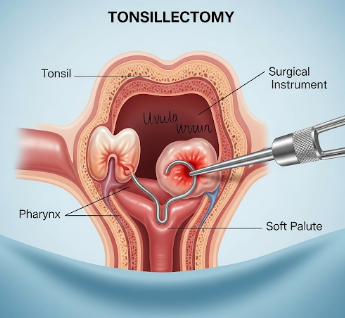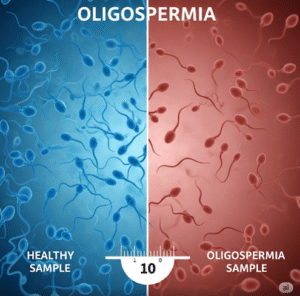Overview
Tonsillectomy is a surgical procedure to remove the tonsils, two lymphoid tissues located at the back of the throat. This surgery is commonly performed to treat recurrent tonsillitis, obstructive sleep apnea, chronic tonsil infections, or enlarged tonsils causing difficulty in breathing or swallowing.
In Korea, tonsillectomy is carried out in specialized ENT and pediatric surgical centers using modern surgical techniques, including cold steel dissection, electrocautery, and laser methods, ensuring precision, safety, and faster recovery.
What is Tonsillectomy?
Tonsillectomy involves complete removal of the tonsils, sometimes along with the adenoids (adenoidectomy) in children.
Key indications include:
- ✦ Recurrent or chronic tonsillitis not responsive to medication.
- ➤ Sleep apnea or snoring due to enlarged tonsils.
- ✦ Difficulty swallowing or breathing caused by hypertrophied tonsils.
- ➤ Suspected malignancy in rare cases.
This procedure helps reduce infections, improve breathing, and enhance overall quality of life.
What are the Benefits?
Tonsillectomy provides several advantages:
✅ Reduces frequency of throat infections.
➤ Improves sleep quality by resolving obstructive sleep apnea.
✦ Enhances breathing and swallowing, particularly in children.
➤ Minimizes abscess formation and chronic inflammation.
✅ Improves overall health, energy, and growth in children.
✦ Safe and effective when performed in specialized Korean centers.
Procedure Details
1) How should I prepare for Tonsillectomy?
Preparation includes:
- ✦ Medical evaluation: review medical history, allergies, medications, and prior surgeries.
- ➤ Laboratory tests: blood count, coagulation profile, and other relevant investigations.
- ✦ Fasting instructions: no food or drink 6–8 hours before surgery.
- ➤ Consent and counseling: discuss procedure type, anesthesia, risks, benefits, and post-surgery care.
- ✦ Medication review: anticoagulants or NSAIDs may need adjustment.
- ➤ Arrange post-operative care: ensure someone can monitor the patient at home after surgery.
2) What happens during the procedure Tonsillectomy?
Tonsillectomy is performed under general anesthesia in a sterile operating room:
➤ Step 1: Patient positioned supine with mouth open using a mouth gag.
✦ Step 2: Tonsils visualized and dissected from surrounding tissue using cold steel, electrocautery, or laser.
➤ Step 3: Bleeding controlled using cautery or sutures.
✦ Step 4: Tonsils removed completely, and wound inspected for hemostasis.
➤ Step 5: If indicated, adenoids may also be removed.
✦ Step 6: Mouth gag removed, patient transferred to recovery room for monitoring.
Korean centers prioritize precise dissection, minimal blood loss, and careful airway management.
3) What happens after Tonsillectomy?
Postoperative care includes:
- ✦ Monitoring: vital signs, airway, and bleeding in recovery.
- ➤ Pain management: oral or IV analgesics for throat pain.
- ✦ Diet: soft, cool foods and plenty of fluids. Avoid rough or spicy foods.
- ➤ Activity: rest for several days; avoid strenuous activity for 1–2 weeks.
- ✦ Follow-up: ENT review to monitor healing and ensure no post-operative complications.
- ➤ Recovery: full recovery typically occurs in 10–14 days, with pain and swelling gradually subsiding.
Risks / Benefits
Potential Risks:
- ✦ Postoperative bleeding (most significant risk).
- ➤ Infection at surgical site (rare).
- ✦ Pain and difficulty swallowing for several days.
- ➤ Temporary changes in taste.
- ✦ Rare complications: dehydration, airway obstruction, or reaction to anesthesia.
Benefits:
- ✅ Reduced frequency of throat infections.
- ✅ Relief from obstructive sleep apnea and improved breathing.
- ✅ Enhanced swallowing and comfort in daily life.
- ✅ Safe and effective procedure in trained Korean ENT centers.
- ✅ Improves overall quality of life and long-term health outcomes.
Recovery and Outlook
Recovery after tonsillectomy generally includes:
- ➤ Immediate care: monitoring for bleeding, airway management, and pain control.
- ✦ Diet: start with liquids and soft foods; avoid acidic or spicy foods.
- ➤ Activity: rest at home, avoid school or work for 7–10 days.
- ✦ Follow-up: ENT review 1–2 weeks post-surgery.
- ➤ Long-term outcome: most patients experience significant reduction in infections, improved sleep, and better quality of life.
When To Call the Doctor
Contact your healthcare provider if you notice:
⚠ Heavy or persistent bleeding.
⚠ Severe pain not controlled by medication.
⚠ Difficulty breathing or swallowing liquids.
⚠ High fever or signs of infection.
⚠ Dehydration or inability to maintain fluid intake.
Best Korea Option / Process
Korea provides world-class tonsillectomy with:
- ✦ Experienced ENT surgeons skilled in pediatric and adult tonsillectomy.
- ➤ Advanced surgical equipment for precise dissection and minimal bleeding.
- ✦ Focus on rapid recovery, minimal pain, and optimal outcomes.
- ➤ Comprehensive pre- and post-operative care, including anesthesia monitoring and follow-up.
- ✦ Safe and effective procedures for domestic and international patients.
- ➤ Multidisciplinary care ensures optimal airway, reduced infection risk, and faster return to normal activities.
Korean centers ensure patients receive safe, precise, and effective tonsillectomy with minimal complications and excellent recovery.
Highlights of Tonsillectomy in Korea
- ✅ Removes tonsils to reduce infections and improve breathing.
- ➤ Minimally invasive techniques for faster recovery.
- ✦ High safety standards with expert anesthesia and ENT teams.
- ➤ Comprehensive post-operative care including pain management and follow-up.
- ✅ Expert care in advanced Korean ENT centers.













